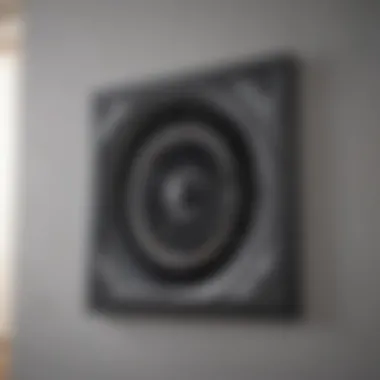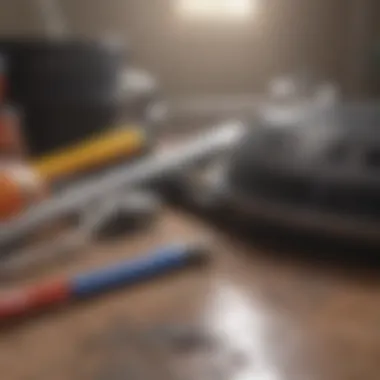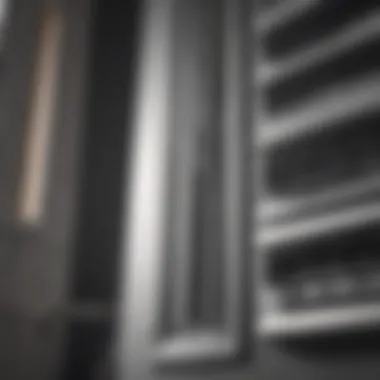A Comprehensive Guide to Cleaning Vents Effectively


Intro
Cleaning vents is often overlooked, yet it plays a significant role in maintaining both indoor air quality and the overall efficiency of household systems. Dust, allergens, and debris can accumulate in vents over time, impacting the air you breathe and your home's aesthetic appeal. This guide aims to provide practical advice and strategies for homeowners who wish to take a proactive approach to their vent cleaning initiatives.
Regular maintenance of vents leads to a multitude of benefits, including improved air flow, reduced allergens, and enhanced energy efficiency. Moreover, it can prolong the lifespan of HVAC systems, translating to cost savings in the long run. This article explores the tools, techniques, safety precautions, and detailed methods to empower homeowners in managing their indoor environment better.
Understanding the different types of vents is crucial in determining the best cleaning approach. Various vent types demand distinct maintenance strategies tailored to their unique characteristics. Throughout this guide, we will navigate through these specifics, ensuring readers possess the knowledge needed for effective cleaning.
By emphasizing a DIY strategy, this article encourages readers to take control not only of the cleanliness of vents but also their home's overall atmosphere. From recognizing trends in air quality to executing successful cleaning routines, the content herein is designed with the discerning home improvement enthusiast in mind.
Foreword to Vent Cleaning
Cleaning vents may not be the first task on a homeowner's mind, yet it is crucial for ensuring good air quality and efficient home systems. Over time, vents accumulate dirt, dust, and debris that can hinder air flow and reduce the effectiveness of HVAC systems. Thus, understanding the significance of vent cleaning goes beyond simple aesthetics; it directly affects health, comfort, and energy efficiency in a home.
Maintaining clean vents contributes to improved indoor air quality. When air passes through dirty vents, it can carry allergens and irritants into living spaces. Individuals with respiratory conditions may find relief by conducting regular maintenance. This action not only benefits personal health but may also enhance the efficiency of heating and cooling systems, helping to reduce energy consumption and lower utility bills.
Furthermore, clean vents can extend the life of HVAC equipment. By keeping the vents unobstructed, the systems operate more smoothly and are less susceptible to breakdowns. Homeowners often overlook the connection between regular vent cleaning and the longevity of their appliances. By dedicating time to this task, one ensures optimal performance and durability.
In summary, highlighting the importance of vent cleaning leads to better informed homeowners. The advantages are clear: improved air quality, energy efficiency, and system longevity are all attainable through a DIY approach to vent maintenance.
Understanding Air Quality
Air quality is a significant factor in maintaining a healthy living environment. Poor air quality can lead to numerous health issues, including respiratory problems, allergies, and fatigue. In the context of vent cleaning, understanding air quality is vital to recognizing the impact that clean vents can have on overall indoor air conditions.
Health Implications
The quality of air inside a home can influence the well-being of its occupants. Contaminants such as dust, pollen, mold, and pet dander can accumulate in vents over time. When the HVAC system operates, these particles circulate through the air, potentially aggravating allergies or triggering asthma attacks. Regular cleaning can help minimize these risks and enhance the air quality.
Efficiency Considerations
Additionally, air quality is not only about health—it relates to energy efficiency as well. Dirty vents can significantly hinder airflow, causing HVAC systems to work harder. This inefficiency can increase energy consumption, leading to higher utility bills. By maintaining clean vents, homeowners can improve air quality while promoting energy efficiency, ultimately saving money in the long term.
Impact of Poor Air Quality
Poor air quality can stem from various sources, including outdoor pollution, indoor pollutants, and household activities. It can lead to multiple health issues, such as respiratory illnesses, headaches, and fatigue.
- Health Risks
- Cognitive Function
Research indicates that poor air quality may affect cognitive performance. This can impact daily tasks and overall quality of life. Simple steps like cleaning vents can facilitate breathing easier.
- Respiratory issues can increase due to inhaling irritants.
- Allergies can be exacerbated by airborne dust and pollen.
- Long-term exposure to poor air could lead to chronic health conditions.
"Indoor air pollution is one of the top five environmental health risks, according to the EPA."
Role of Vents in Air Circulation
Vents play a pivotal role in maintaining indoor air quality by facilitating proper air circulation. They help distribute conditioned air throughout the home, ensuring consistent temperatures and reducing humidity levels.
- Efficient Airflow
- Prevention of Moisture Buildup


- Properly functioning vents can improve air circulation, contributing to a more comfortable home environment.
- They help to balance the pressure in a home, essential for energy-efficient heating and cooling.
- Clean vents can help prevent moisture buildup, which might encourage mold growth. Mold can further degrade air quality and pose health risks.
- Regular maintenance helps to keep vents clear, promoting healthy airflow.
In summary, understanding the connection between air quality and the cleanliness of vents is crucial for homeowners. Regular vent cleaning not only promotes a healthier living space but also enhances the efficiency of HVAC systems, which can lead to significant savings in energy costs.
Preparing for a DIY Vent Cleaning
Preparing for a DIY vent cleaning is an essential phase that lays the groundwork for a successful outcome. This stage involves gathering important items and planning for the task ahead. Taking time to prepare can enhance safety, effectiveness, and overall satisfaction with the cleaning process. Without adequate preparation, things can go wrong. For instance, lack of the right tools can lead to ineffective cleaning or even damage to the vent system.
Additionally, being aware of the steps prior to cleaning can save time and prevent frustration. It ensures that the DIY venture can be completed efficiently, allowing for improved indoor air quality more quickly. Having a clear plan allows homeowners to approach the task methodically.
Necessary Tools and Materials
To effectively clean vents, you will require specific tools and materials. The proper equipment can make the process smoother and more effective. Here are the critical items you should have on hand:
- Vacuum Cleaner: Preferably one with a hose attachment for reaching tight spaces.
- Brushes: A vent brush or a flexible duct brush can be very useful in removing dust and debris.
- Screwdriver: For removing vent covers easily.
- Safety Goggles: To protect your eyes from dust and allergens.
- Gloves: To keep your hands safe and clean.
- Towels or Cloths: Useful for wiping down surfaces and catches any falling dust.
By having these tools ready, you ensure that the cleaning process is not interrupted. Efficient preparation leads to better results and a more pleasant experience overall.
Safety Precautions
Safety should never be overlooked during DIY projects, particularly when cleaning vents. There are several precautions that can minimize risks:
- Turn Off Power: Always make sure to turn off any HVAC systems before you begin. This prevents accidents and protects the equipment during the cleaning.
- Ensure Proper Ventilation: Open windows if possible. This helps improve air circulation, ensuring that any dust dislodged during cleaning dissipates quickly.
- Use Gloves and Safety Goggles: These items provide essential protection against dust, dirt, and potentially sharp edges.
- Be Cautious on Ladders: If vent access requires a ladder, ensure that it is stable. Avoid overreaching while on the ladder, as this can lead to falls.
"Safety is a priority in DIY practices. Taking small steps to protect yourself pays off in the end."
By adhering to these safety measures, you reduce the likelihood of accidents occurring during the vent cleaning process. Understanding the significance of preparation paves the way for a more successful and less stressful experience.
Identifying Vent Types
Identifying the different types of vents in your home is crucial for effective cleaning and maintenance. Each vent type serves a specific function in your home’s ventilation system. Understanding these differences will help homeowners focus their cleaning efforts where they are most needed and ensure that air quality remains optimal. Different vents can accumulate various kinds of dirt and debris, affecting both functionality and aesthetics. Thus, familiarity with vent types can aid in proper maintenance practices, signifying a proactive approach to indoor air quality.
HVAC Vents
HVAC vents are integral to a home’s heating, ventilation, and air conditioning system. They distribute heated or cooled air throughout the home, ensuring consistent temperature control. These vents are usually found in living areas, bedrooms, and basements. Because HVAC vents operate regularly, they can become clogged with dust and pet dander. Regular cleaning of these vents is necessary to maintain airflow efficiency. When obstructed, they can lead to higher energy bills and uneven heating or cooling. Thus, identifying and understanding the HVAC vents in your home is necessary for enhanced efficiency.
Dryer Vents
Dryer vents are designed for air exhaust from the dryer. They help in expelling moist air, lint, and other particles during the drying process. Keeping these vents clean is essential because lint buildup can pose a significant fire hazard. Moreover, clogged dryer vents decrease drying efficiency, making your dryer work harder and consume more energy. Homeowners should regularly inspect and clean dryer vents to prevent blockages. This vigilant monitoring ensures that the dryer performs correctly for an extended period and remains safe to use.
Bathroom and Kitchen Vents


Bathroom and kitchen vents are necessary for removing moisture and odors. In kitchens, these vents help to expel steam and smells created during cooking. Bathroom vents, on the other hand, prevent mold and mildew by removing humidity after showers or baths. Both vent types can gather grease in kitchens and moisture in bathrooms, leading to inefficient operation if not cleaned regularly. Homeowners should identify these vents and incorporate them into their cleaning routine. Understanding these functions helps ensure a healthier living environment and prevents long-term damage related to excess moisture.
Step-by-Step Vent Cleaning Process
The process of cleaning vents is essential for maintaining a healthy indoor environment. This affects both air quality and overall efficiency of home systems. When dust and debris accumulate in vents, it can lead to reduced air flow. Consequently, this can strain HVAC systems, elevating energy costs. A methodical approach to vent cleaning ensures that every component receives attention. This step-by-step guide serves not only to educate but also empowers homeowners to take action.
Turning Off HVAC Systems
Before beginning any cleaning process, it is crucial to turn off all HVAC systems. This step minimizes the risk of accidental injury or damage. It prevents the system from cycling air throughout the house while you clean. Additionally, it helps avoid the spread of dust into the room air. Just locate the thermostat or the main power switch for the unit and ensure it is completely off. This simple action establishes a safe environment for the work ahead.
Removing Vent Covers
Once the HVAC system is off, the next task is to remove the vent covers. This is typically done by unscrewing or gently prying the cover from its mounting. A flat-head screwdriver may assist in cases where the covers are tightly fitted. Ensure you place the screws in a safe location to avoid losing them. Handling covers with care will prevent any bending or breakage, prolonging their life. Once removed, dust and debris will become much more accessible.
Cleaning Techniques for Different Vents
To effectively clean vents, various techniques can be utilized based on the type of vent. Each method has its own characteristics and advantages which contribute to successful cleaning.
Using a Vacuum Cleaner
Using a vacuum cleaner is one of the most popular methods for vent cleaning. Its strong suction capabilities can remove loose dust and debris. This method is efficient and requires minimal effort. Ensure to use a nozzle attachment designed for tight spaces. An important feature of vacuum cleaners is their versatility; they can be used on multiple surfaces and in various locations. However, vacuums may not reach deeply embedded dirt, which can be a drawback.
Utilizing a Brush
Utilizing a brush is another effective cleaning technique. A long-handled brush can reach deep into vents and remove stubborn build-up. Brushes can penetrate areas that a vacuum might miss. For vents with a more rigid structure, a bristle brush works well. This technique helps ensure a thorough clean. Just take care not to scratch or damage the vent surfaces whilst scrubbing. A downside might be that it requires more physical effort compared to using vacuum cleaners.
Employing Chemical Cleaners
Employing chemical cleaners can enhance the cleaning process, especially for grease or sticky residues often found in kitchen vents. These cleaners can break down tough grime, making it easier to wipe away. Always read the label for safe usage and suitable application methods. An essential feature is that they can provide a level of deep cleaning not achievable with mechanical methods alone. Nevertheless, there are potential disadvantages, including chemical residues and odors that may linger if not properly ventilated.
Reassembling Vent Covers
After the cleaning process is complete, it is essential to reassemble the vent covers with care. Align the cover to its original position and secure it firmly without overtightening. Check that it is flush against the wall or ceiling to avoid any air leaks. Proper reassembly ensures the vent system operates efficiently post-cleaning. This step also helps prevent issues related to loose or misaligned covers, which could affect air circulation.
Restarting HVAC Systems
Finally, once all covers are securely in place, it is time to restart the HVAC systems. This can typically be done via the thermostat or the main power switch. Check that everything operates smoothly and quietly. Observe the airflow to make sure it feels even throughout the space. Restarting the system signals the completion of the cleaning, and a notice of improved performance may follow.
Post-Cleaning Considerations
After you have completed the cleaning of your vents, understanding the implications of this task is crucial. The immediate benefit is the improved airflow, which directly enhances the overall efficiency of your HVAC system. Poor airflow can lead to increased energy bills and reduced comfort. Ensuring vents are free of obstructions optimizes home heating and cooling, promoting more consistent temperatures throughout your living spaces.
Additionally, clean vents significantly contribute to indoor air quality. Dust, allergens, and other particles accumulate in vents over time. With thorough cleaning, you mitigate the risk of respiratory problems triggered by poor air quality. Furthermore, this practice aids in eliminating musty odors that may arise from dust and debris build-up. Thus, post-cleaning considerations should be focused on long-term air quality and efficiency benefits.


Improving Indoor Air Quality
To appreciate the significance of post-cleaning, consider the positive impacts on indoor air quality. Cleaning vents removes a collection of dust, pollen, and mold spores that, if left unchecked, circulate in your home. Preventive measures ensure that air remains fresh and healthy.
- Improve respiratory health by reducing airborne allergens.
- Decrease the likelihood of mold formation due to excess moisture trapped in dirty vents.
- Enhance overall wellbeing by ensuring cleaner air in the spaces where you spend time.
Regular vent maintenance allows homeowners to breathe easier, particularly for those with allergies or asthma. Integrating air purifiers in conjunction with clean vents can amplify your indoor air quality measures.
"Clean vents lead to a cleaner home. They help promote healthier air, allowing families to thrive amidst a cluttered world."
Scheduled Maintenance Practices
Consistency is key. Implementing a scheduled maintenance practice is essential to uphold the standards set by your recent vent cleaning. Consider establishing a routine, perhaps every three to six months. This assures that the vents remain clear and that the air quality stays within optimum levels.
- Create a checklist for vent cleaning tasks, referring to appropriate tools and safety precautions outlined previously.
- Mark your calendar for reminders, integrating vent cleaning into regular home maintenance schedules.
- Assess air filters and replace them if they appear clogged or dirty, complementing your cleaning efforts.
Integrity of the system can be gauged by monitoring HVAC performance. If you observe a drop in efficiency, revisit your cleaning and maintenance routine. Well-maintained vents sustain indoor climates with little additional energy consumption, supporting both environmental and economic interests.
Closure
The act of cleaning vents not only enhances the aesthetic of your home but also plays a pivotal role in promoting overall health and efficiency in your living space. Consistent maintenance of air vents contributes to improved air quality and better airflow, which are fundamental for a conducive environment. In this increasingly aware world, making the decision to engage with DIY vent cleaning can seem daunting, yet the benefits significantly outweigh the initial hesitance.
Benefits of DIY Vent Cleaning
- Cost-Effective: Hiring professionals can incur considerable costs. By undertaking vent cleaning yourself, you save money and understand the intricacies of your own home systems.
- Enhanced Air Quality: Dust, allergens, and mold can accumulate in vents if they are neglected. Regular cleaning decreases these unhealthy particulates, leading to clearer, cleaner air throughout your home.
- Increased Energy Efficiency: Clean vents facilitate the efficient functioning of HVAC systems. When airflow is unrestricted, systems do not have to overwork, reducing energy consumption and potentially lowering utility bills.
- Personal Insight: Conducting maintenance provides valuable knowledge about your home’s air circulation systems. It enables you to identify early signs of potential issues, allowing for timely interventions.
- Health Benefits: Clean air is vital for good health. Removing allergens and toxins minimizes the risk of respiratory problems, especially for vulnerable individuals.
- Aesthetics: Clean vents contribute to an overall polished look in your home. It reflects care and attention to details, particularly important when hosting gatherings or events.
"Regular vent cleaning exponentially improves air circulation, enhances comfort, and fosters a healthier living environment."
Ultimately, engaging in vent cleaning is more than a chore; it is a proactive step towards maintaining a healthy home. By placing emphasis on a DIY approach, homeowners, interior design enthusiasts, and anyone invested in their space can empower themselves with knowledge and practical skills. The commitment to keeping vents clean yields dividends not just in immediate aesthetics, but also in long-term health and efficiency.
Further Reading and Resources
Engaging in DIY vent cleaning is only one step in achieving cleaner indoor air and a more efficient home. Understanding the broader scope of air quality and maintenance practices can significantly enhance the effectiveness of your efforts. This section emphasizes the role of further reading and valuable resources that can provide deeper insight into vent cleaning and overall air quality improvement.
Vent Cleaning Guides
Vent cleaning guides are essential for homeowners who seek comprehensive knowledge on this topic. These guides not only outline specific cleaning methods but also delve into the rationale behind each technique. Proper guides can offer detailed insights about different types of vents, their unique cleaning needs, and the common mistakes to avoid.
- Resourcefulness: Guides can frequently be found in different formats including blogs, e-books, and publications. This variety enables every reader to find something that meets their learning preference.
- Step-by-step tutorials: Specific tutorials can guide you through each process, from tools needed to safe handling practices. Clear visuals often accompany these resources to provide a better understanding of the methods utilized.
- Expert Opinions: Many guides are written or endorsed by seasoned professionals. They share personal experiences and best practices, which can lend credibility and assurance to the methods presented.
Air Quality Improvement Tips
Improving indoor air quality is a collective endeavor that extends beyond cleaning vents. Tips for enhancing air quality can include optimizing ventilation systems, utilizing air purifiers, and introducing houseplants that filter air. Knowledge of these additional measures is vital for homeowners interested in creating a healthier living environment.
- Comprehensive approaches: Research suggests that tackling air quality involves a multi-faceted approach. Combining vent cleaning with air filtration systems, humidity control, and proper ventilation can yield the best results.
- Lifestyle changes: Simple adjustments in daily habits, such as regular dusting and the elimination of harmful pollutants, can significantly influence air quality over time.
- Engagement with communities: Online platforms, such as Reddit or Facebook groups, can provide community-based insights and shared experiences. Engaging with others who are passionate about air quality can help you discover unique tips and effective methods that may often be overlooked.
Knowledge is power. By equipping yourself with information from reputable sources, you can enhance your DIY skills and take informed steps toward a healthier home environment.
Ultimately, further reading and exploring relevant resources is an investment in your home’s air quality. By expanding your understanding beyond the initial cleaning process, you will be better prepared to manage indoor air effectively, ensuring long-term benefits for yourself and your family.



